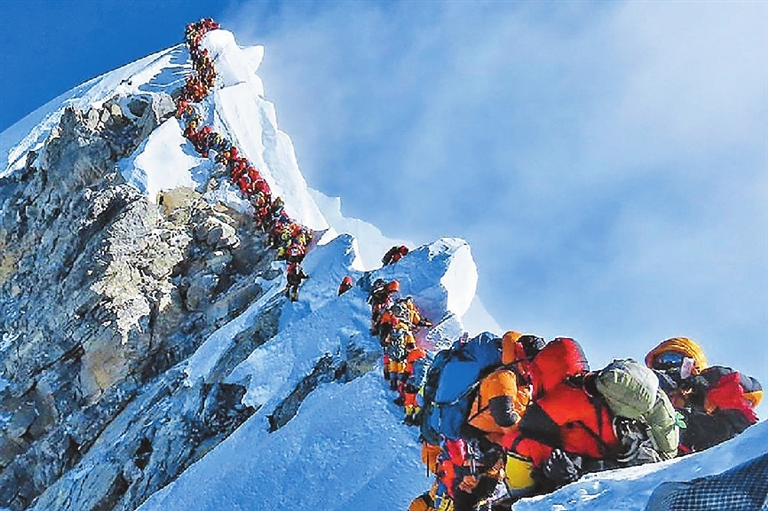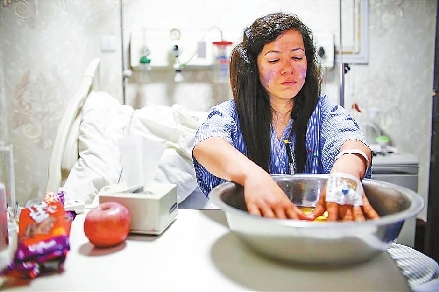

ELEVEN climbers died on Mount Qomolangma, also known as Everest, the world’s highest mountain, in a two-week span last month, making 2019 one of the deadliest climbing seasons in memory. Conditions on the mountain are always dangerous, but overcrowding has led to climbers standing in line for hours in the “death zone,” where they risk running out of oxygen, becoming exhausted and falling off steep cliffs. The rash of deaths — which many believe to be avoidable — has led to questions over who is responsible for creating such dangerous conditions in what is already a perilous place. Many are blaming the overcrowding on the government of Nepal, which issued a record number of permits to climb the mountain this season. Others have pointed to unscrupulous trekking companies that are sending climbers who aren’t fit for the journey up the mountain with subpar equipment. The situation is reportedly made more precarious by climbers’ obsession with reaching the top. The so-called summit fever may cause some people to ignore signs that they’re in danger, and some have described seeing fellow climbers lose empathy for those around them in need. Inexperienced climbers Ameesha Chauhan, a survivor of the Qomolangma “traffic jam” who is in a hospital recovering from frostbite, said climbers without basic skills should be barred to prevent a recurrence of this year’s deadly season on the world’s highest peak. Nepal issued a record 381 Qomolangma permits this season, and several hundred summiteers were not properly trained, took poor decisions and “put their own life at risk and also of the Sherpa guides,” Chauhan said. The 29-year-old Indian had to wait 20 minutes to come down from the 8,844-meter peak, but others were held up for hours. “I saw some climbers without basic skills fully relying on their Sherpa guides. The government should fix the qualification criteria,” she said. “Only trained climbers should be granted the permit to climb Qomolangma.” At least four deaths have been blamed on over-crowding with teams waiting sometimes for hours in the “death zone” where the cold is bitter, the air dangerously thin and the terrain treacherous. This year’s Qomolangma toll is the highest since 2014-15, when huge earthquakes triggered devastating avalanches. “Many climbers’ oxygen was running out,” Chauhan said. “Some climbers died due to their own negligence. They insisted on reaching the top even if their oxygen was running out.” This year, about 90 percent of the climbers at Qomolangma are first-timers. Lack of professional training and experience as well as undetected health issues should be mainly blamed for the casualties on the mountain rather than the traffic jam, said Ma Liyamu, who reached the top of Qomolangma on May 22. “Some expedition companies failed to prepare the climbers for crowded conditions, which is really irresponsible.” Another climber, the “adventure filmmaker” Elia Saikaly, posted on Instagram on May 26 that he had reached the summit of Qomolangma and “cannot believe what I saw up there.” “Death. Carnage. Chaos. Lineups. Dead bodies on the route and in tents at camp 4. People who I tried to turn back who ended up dying. People being dragged down. Walking over bodies,” Saikaly wrote. “Everything you read in the sensational headlines all played out on our summit night.” Permits not to be cut But after 11 people died this year, Nepal tourism officials have no intention of restricting the number of permits issued, instead encouraging even more tourists and climbers to come “for both pleasure and fame,” said Mohan Krishna Sapkota, secretary at the Ministry of Tourism and Civil Aviation. Nepal, one of the world’s poorest countries, relies on the climbing industry to bring in US$300 million each year. It doesn’t cap the number of permits it issues or control the pace or timing of the expeditions, leaving that to tour operators and guides who take advantage of brief clear weather whenever they come, leading to pileups near the peak. On May 22, a climber snapped a photo from a line with dozens of hikers in colorful winter gear that snaked into the sky. Climbers were crammed crampon-to-crampon along a sharp-edged ridge above South Col, with a 2,000-meter drop on either side, all clipped onto a single line of rope, trudging toward the top of the world and risking death as each minute ticked by. “There were more people on Everest than there should be,” said Kul Bahadur Gurung, general secretary of the Nepal Mountaineering Association, an umbrella group of all expedition operators in Nepal. “We lack the rules and regulations that say how many people can actually go up and when.” Once only accessible to well-heeled elite mountaineers, Nepal’s booming climbing market has driven down the cost of an expedition, opening Qomolangma up to hobbyists and adventure-seekers. Nepal requires climbers to have a doctors’ note deeming them physically fit, but not to prove their stamina at such extreme heights. Because of the altitude, climbers have just hours to reach the top before they are at risk of a pulmonary oedema, when the lungs fill with liquid. From Camp Four at 8,000 meters to the 8,844-meter peak, the final push on Qomolangma is known as the “death zone.” “Every minute counts there,” said Eric Murphy, a mountain guide from Bellingham, Washington, who climbed Everest for a third time May 23. He said what should have taken 12 hours took 17 hours because of struggling climbers who were clearly exhausted but had no one to guide or help them. Just a handful of inexperienced climbers, he said, is “enough to have a profound effect.” Nepal doesn’t have any regulations to determine how many permits should be issued, so anyone with a doctor’s note can obtain one for an US$11,000 fee, Sapkota said. This year, permits were issued to 381 people in 44 teams, the highest number ever, according to the government. They were accompanied by an equal number of Sherpas. Instead of the overcrowding, Sapkota blamed the weather, equipment and inadequate supplemental oxygen for this year’s deaths. “There has been concern about the number of climbers on Mount Everest but it is not because of the traffic jam that there were casualties,” Sapkota said in Namche, the town that serves as the staging area for Qomolangma trips. Still, he said, “in the next season we will work to have double rope in the area below the summit so there is better management of the flow of climbers.” Mirza Ali, a Pakistani mountaineer and tour company owner who reached Qomolangma’s peak for the first time this month, on his fourth attempt, said the approach to attract climbers for profits was flawed. “Everybody wants to stand on top of the world” but tourists unprepared for the extremes of Qomolangma endanger the entire industry, he said. “There is not a sufficient check on issuing the permits,” Ali said. “The more people come, the more permits, more business. But on the other side it is a lot of risk because it is costing lives.” Role of social media Social media culture also drives climbers to take unnecessary risks. “It’s the need to show a sense of self worth and post on social media. Like it or not, we are all caught up in an unstoppable personal PR machine of displaying our significance to the world. Or, in layman’s terms, ‘Look where I am, look what I’m doing or look what I’ve got,’” climber Adrian Hayes said. While the Nepalese tourism board has no plans to limit the number of permits it issues next year, whether the recent spate of deaths will cause fewer climbers to make the trip will likely not be clear until the start of the 2020 climbing season next spring. (SD-Agencies) | 
